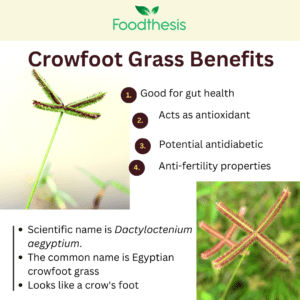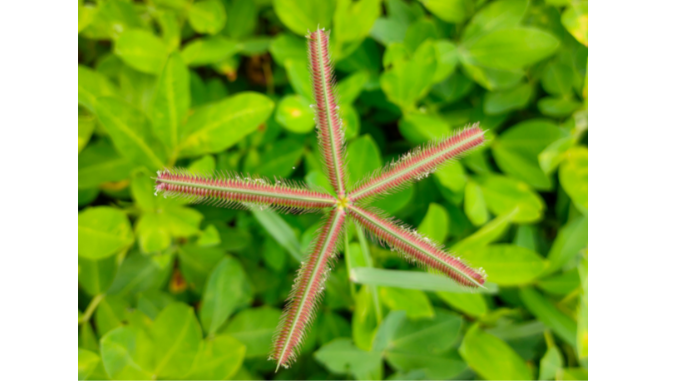Know in one minute about Crowfoot grass
|
Crowfoot grass scientific name is Dactyloctenium aegyptium. Is a densely bunched grass belonging to the Poaceae family. It is a nutritional-rich grain, used traditionally as a famine food in Africa and given to women suffering from bellyache after childbirth.
This grass has a crowfoot name because its seed head looks like a crow’s foot. It has straight shoots with grass-like leaves and flowers that arise at the tip of the stems.
The whole plant of crowfoot may treat gastrointestinal disorders, kidney diseases, ulcers, backache, and smallpox. It also has potential antioxidant, anti-inflammatory, antipyretic, and antimicrobial activity.
Common name
Crowfoot Grass, beach wiregrass, coast button grass, comb fringe grass, Duck grass, Durban crowfoot, Egyptian finger grass, Egyptian crowfoot grass, finger comb grass, four-finger grass
Geographical distribution
This grass is native to Africa, tropical Asia, and the Middle East but naturalized worldwide.
Nutritional value of crowfoot
A research study reported that the plant contained carbohydrates, proteins, amino acids alkaloids, saponins, tannins, flavonoids, terpenoids, steroids, fixed oils, and phenols (1).
Health benefits of crowfoot grass
1. Possible Antioxidant properties
It possesses phenols and flavonoid contents that g from damages caused by harmful molecules such as free radicals. Thus, intake of this grass may lowers the risk of infections and improves health (2).
3. May have anti-diabetic properties
Contains bioactive flavonoids that decrease blood glucose levels and increase insulin levels. Thus, intake of this plant decreases oxidative stress and brings down the severity of diabetes (4).
4. Good for the gut
It contains both spasmogenic and spasmolytic activity due to the presence of two components (cholinomimetic and calcium antagonistic). It helps to induce spasms and causes relaxation of gastrointestinal smooth muscles thus treating constipation and diarrhea (5).
5. Potential antimicrobial properties
Is rich in antimicrobial components like flavonoids that inhibit the growth of various bacteria; fungi and viruses thus treating infection (6, 7).
6. May have anti-fertility properties
The presence of saponins, flavonoids, tannins, and alkaloids in crowfoot grass may possess anti-fertility activity.
A research study suggested that intake of this grass decreases the sperm count and reproductive organs’ weight. It also reduces serum hormonal levels and no. breeding rates thus crowfoot may be useful for men to control birth (8).

7. Other properties
The leaves of this grass are crushed and chewed raw or paste in water is applied topically (9). In some African tribes, seed extraction and decoctions are used orally after childbirth to relieve bellyache. Crowfoot can be used as a detoxifier and anti-allergic (10). It also treats jaundice, immune deficiency, wounds, fever, and biliary and urinary disease (11).
The side effects of Crowfoot
The taste is unpleasant and consumption may cause internal disorders.
How to eat crowfoot grass?
Crowfoot grass has been used as a cereal substitute in periods of food scarcity. The grain can be cooked after milling into flour to make chapattis or halwa. It can be used after being boiled as porridge or brewed to make beer, or baked into cakes. The meal has a pleasant odor and can be easily digestible after cooking (12).
